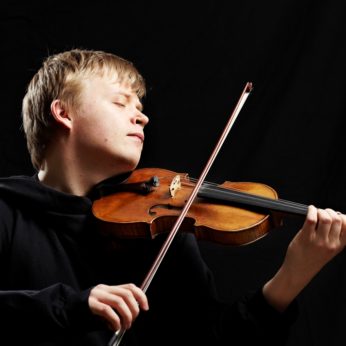Composer: Johann Sebastian Bach (b. 1685 - d. 1750)
Performance date: 30/06/2010
Venue: St. Brendan’s Church
Composition Year: 1720
Duration: 00:57:39
Recording Engineer: Anton Timoney, RTÉ lyric fm
Instrumentation Category:Solo
Instrumentation Other: vn, electric vn
Artists:
Pekka Kuusisto -
[violin]

The
Chaconne is the most wonderful, unfathomable piece of music. On
one stave, for a small instrument, the man writes a whole world of
the deepest thoughts and most powerful feelings. If I imagined that I
could have created, even conceived the piece, I am quite certain that
the excess of excitement and earth shattering experience would have
driven me out of my mind.
Johannes Brahms
Bach’s
most important instrumental works were written during his six years
at Cöthen 1717-1723, where he was Kapellmeister for the musical
Prince Leopold Anhalt-Cöthen. For a brief time Cöthen put Bach in a
musically ideal situation. First he was working with an ensemble
whose professional core group comprised some of the finest musicians
in that part of the world. Secondly the demands of his job left him
considerable time to pursue his own interests. Thirdly and most
importantly he found himself under the patronage of a supportive and
understanding prince.
Bach’s
time at Cöthen was marred by the sudden death of his first wife,
Maria Barbara, in 1720. Bach’s autograph manuscript of the sonatas
and partitas is also dated 1720 and the extraordinary nature of the
famous Chaconne has led to conjecture that it was written in memory
of his wife.
The
D minor Partita presents the dances in their traditional sequence of
Allemande, Courante, Sarabande and Gigue. The Chaconne is placed last
and the perhaps unintentional effect is to make the preceding dances
as a whole appear as a prelude. The
Chaconne is a special
type of continuous
theme and
31
variations where
a somewhat short subject is relentlessly repeated and varied. The
variations are built on a descending ground bass to the rhythm of a
slow dance similar to the Sarabande in simple triple time and often
in a minor key. All of Bach´s genius and musical mastery are found
in the Chaconne and it inspires all manner of superlatives. Certainly
when listening to this music it is sometimes hard to believe what you
are hearing, your mind keeps saying that this cannot be possible.
Philipp Spitta, the great Bach scholar summed it up quite simply as
a triumph of spirit over matter.
Improvisations
on the Hidden Chorales
Through
a close study of the Bach D Minor Partita, the musicologist Helga
Thoene has developed the hypothesis that the piece is encrypted with
references to various Bach chorales, as well as numerological
references to passages in the Bible. The musical quotations and
insinuations help to link passages in the piece to the lyrics of the
chorales, binding their subjects of death and resurrection to the
Partita, as in the Chaconne which is framed by Bach’s melody from
the cantata BWV4. The text of this Cantata is Martin Luther’s
Easter Hymn
Christ Lay in Deaths Bondage
and reference to the lyrics reveals the Chaconne to be a startling
homage to and prayer for his recently deceased wife Maria Barbara.
The
more study that is done, the more links are found that connect each
note to a world of musical and religious symbolism, demonstrating
that Bach managed to condense a veritable cosmology into the third
Partita. C.P.E. Bach wrote in an obituary; that
if ever a musician has placed the most arcane secrets of harmony into
the most ingenious outpourings of his art, it was our Bach. It
seems increasingly so that this sentiment can be taken less as a
humble compliment than a hint at the depths of hidden meaning that
Bach’s works contain.
An
influential recording by The Hilliard Ensemble and Christoph Poppen
has helped to bridge the link between Theone’s analytic musicology
and performance practice, demonstrating that if the lines from the
chorales were sung atop the Chaconne, it is as if the subliminal
connotations of the piece are suddenly revealed. This was taken a
step further; the chorales found in the other movements of the
Partita extracted and played between the movements, revealing a
remarkable thematic consistency.
Pekka
Kuusisto seeks to resurrect the hidden chorales, not through the use
of extra instruments and voices, but by using an electric violin and
technology that will enable him to record and over-dub multiple
strands of melody live on stage, improvising around the themes of the
chorales between the movements of the Partita. The flexibility of the
improvisations contrasted with the mighty edifice of the Partita will
help to cast the latter in a new and mysterious light, teasing out
some of the infinite melodic possibilities refracted by Bach’s
composition.
Copyright © 2025 West Cork Music. All rights reserved.
Designed and developed by Matrix Internet